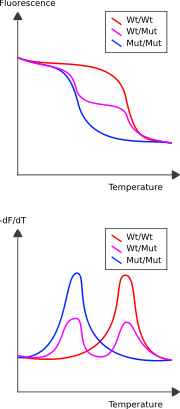
Melting curve analysis
Encyclopedia
Melting curve analysis is an assessment of the dissociation-characteristics of double-stranded DNA during heating. The information gathered can be used to infer the presence and identity of single-nucleotide polymorphisms.
 The energy required to break the base-base hydrogen bonding between two strands of DNA is dependent on their length, GC content and their complementarity. By heating a reaction-mixture that contains double-stranded DNA sequences and measuring dissociation against temperature, these attributes can be inferred.
The energy required to break the base-base hydrogen bonding between two strands of DNA is dependent on their length, GC content and their complementarity. By heating a reaction-mixture that contains double-stranded DNA sequences and measuring dissociation against temperature, these attributes can be inferred.
Originally strand dissociation was observed using UV absorbance measurements, but techniques based on fluorescence measurements are now the most common approach.
The temperature-dependent dissociation between two DNA-strands can be measured using a DNA-intercalating fluorophore
such as SYBR green
, EvaGreen or fluorophore-labelled DNA probes. In the case of SYBR green (which fluoresces 1000-fold more intensely while intercalated in the minor groove of two strands of DNA), the dissociation of the DNA during heating is measurable by the large reduction in fluorescence that results. Alternatively, juxtapositioned probes one featuring a fluorophore and the other, a suitable quencher can be used to determine the complementarity of the probe to the target sequence.
The graph of the negative first derivative of the melting-curve may make it easier to pin-point the temperature of dissociation (defined as 50% dissociation), by virtue of the peaks thus formed.
SYBR Green enabled product differentiation in the LightCycler in 1997. Hybridization probes (or FRET probes) were also demonstrated to provide very specific melting curves from the single-stranded (ss) probe-to-amplicon hybrid. Idaho Technology and Roche have done much to popularize this use on the LightCycler instrument.
alleles by virtue of the dissociation patterns produced. Without probes, until recently amplicon melting (melting and analysis of the entire PCR product) was not generally successful at finding single base variants through melting profiles. With higher resolution instruments and advanced dyes amplicon melting analysis of one base variants is now possible with several instruments commercially available. For example: Applied Biosystems 7500 Fast System and the 7900HT Fast Real-Time PCR System, Idaho Technology's LightScanner (the first plate-based high resolution melting device), Qiagen's Rotor-Gene instruments, and Roche's LightCycler 480 instruments.
Many research and clinical examples exist in the literature that show the use of melting curve analysis to obviate or complement sequencing efforts, and thus reduce costs.
While most qPCR machines have the option of melting curve generation and analysis, the level of analysis and software support varies. High Resolution Melting High Resolution Melt
(known as either Hi-Res Melting, or HRM) is the advancement of this general technology and has begun to offer higher sensitivity for SNP detection within an entire dye-stained amplicon. It is less expensive and simpler in design to develop probeless melting curve systems. However, for genotyping applications, where large volumes of samples must be processed, the cost of development may be less important than the total throughput and ease of interpretation, thus favoring probe-based genotyping methods.
Implementation

Originally strand dissociation was observed using UV absorbance measurements, but techniques based on fluorescence measurements are now the most common approach.
The temperature-dependent dissociation between two DNA-strands can be measured using a DNA-intercalating fluorophore
Fluorophore
A fluorophore, in analogy to a chromophore, is a component of a molecule which causes a molecule to be fluorescent. It is a functional group in a molecule which will absorb energy of a specific wavelength and re-emit energy at a different wavelength...
such as SYBR green
SYBR Green
SYBR Green I is an asymmetrical cyanine dye used as a nucleic acid stain in molecular biology. SYBR Green I binds to DNA. The resulting DNA-dye-complex absorbs blue light and emits green light . The stain preferentially binds to double-stranded DNA, but will stain single-stranded DNA with lower...
, EvaGreen or fluorophore-labelled DNA probes. In the case of SYBR green (which fluoresces 1000-fold more intensely while intercalated in the minor groove of two strands of DNA), the dissociation of the DNA during heating is measurable by the large reduction in fluorescence that results. Alternatively, juxtapositioned probes one featuring a fluorophore and the other, a suitable quencher can be used to determine the complementarity of the probe to the target sequence.
The graph of the negative first derivative of the melting-curve may make it easier to pin-point the temperature of dissociation (defined as 50% dissociation), by virtue of the peaks thus formed.
SYBR Green enabled product differentiation in the LightCycler in 1997. Hybridization probes (or FRET probes) were also demonstrated to provide very specific melting curves from the single-stranded (ss) probe-to-amplicon hybrid. Idaho Technology and Roche have done much to popularize this use on the LightCycler instrument.
Applications
Since the late 1990s product analysis via SYBR Green, other double-strand specific dyes, or probe-based melting curve analysis had become nearly ubiquitous. The probe-based technique is sensitive enough to detect single-nucleotide polymorphisms (SNP) and can distinguish between homozygous wildtype, heterozygous and homozygous mutantMutant
In biology and especially genetics, a mutant is an individual, organism, or new genetic character, arising or resulting from an instance of mutation, which is a base-pair sequence change within the DNA of a gene or chromosome of an organism resulting in the creation of a new character or trait not...
alleles by virtue of the dissociation patterns produced. Without probes, until recently amplicon melting (melting and analysis of the entire PCR product) was not generally successful at finding single base variants through melting profiles. With higher resolution instruments and advanced dyes amplicon melting analysis of one base variants is now possible with several instruments commercially available. For example: Applied Biosystems 7500 Fast System and the 7900HT Fast Real-Time PCR System, Idaho Technology's LightScanner (the first plate-based high resolution melting device), Qiagen's Rotor-Gene instruments, and Roche's LightCycler 480 instruments.
Many research and clinical examples exist in the literature that show the use of melting curve analysis to obviate or complement sequencing efforts, and thus reduce costs.
While most qPCR machines have the option of melting curve generation and analysis, the level of analysis and software support varies. High Resolution Melting High Resolution Melt
High Resolution Melt
High Resolution Melt analysis is a powerful technique in molecular biology for the detection of mutations, polymorphisms and epigenetic differences in double-stranded DNA samples. It was discovered and developed by Idaho Technology and the University of Utah. It has advantages over other...
(known as either Hi-Res Melting, or HRM) is the advancement of this general technology and has begun to offer higher sensitivity for SNP detection within an entire dye-stained amplicon. It is less expensive and simpler in design to develop probeless melting curve systems. However, for genotyping applications, where large volumes of samples must be processed, the cost of development may be less important than the total throughput and ease of interpretation, thus favoring probe-based genotyping methods.
See also
- High Resolution Melt AnalysisHigh Resolution MeltHigh Resolution Melt analysis is a powerful technique in molecular biology for the detection of mutations, polymorphisms and epigenetic differences in double-stranded DNA samples. It was discovered and developed by Idaho Technology and the University of Utah. It has advantages over other...
- Microscale ThermophoresisMicroscale ThermophoresisMicroscale Thermophoresis is a technology for the analysis of biomolecules. Microscale Thermophoresis is the directed movement of particles in a microscopic temperature gradient...
a method to determine the stability, the length, the conformation and the modifactions of DNA and RNA

